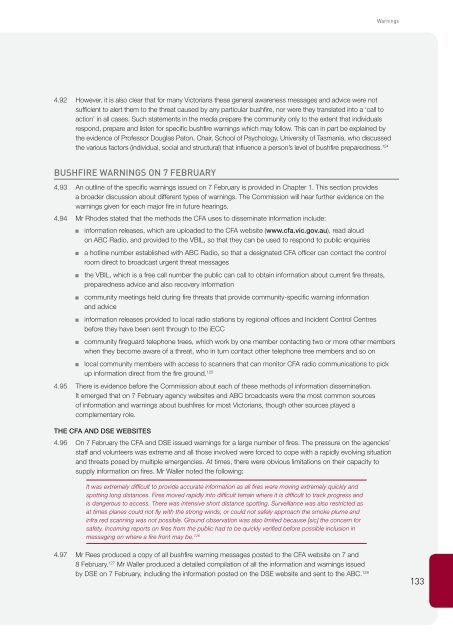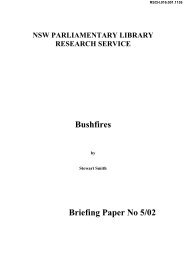Chapter 4 - Warnings - 2009 Victorian Bushfires Royal Commission
Chapter 4 - Warnings - 2009 Victorian Bushfires Royal Commission
Chapter 4 - Warnings - 2009 Victorian Bushfires Royal Commission
Create successful ePaper yourself
Turn your PDF publications into a flip-book with our unique Google optimized e-Paper software.
<strong>Warnings</strong><br />
4.92<br />
However, it is also clear that for many <strong>Victorian</strong>s these general awareness messages and advice were not<br />
sufficient to alert them to the threat caused by any particular bushfire, nor were they translated into a ‘call to<br />
action’ in all cases. Such statements in the media prepare the community only to the extent that individuals<br />
respond, prepare and listen for specific bushfire warnings which may follow. This can in part be explained by<br />
the evidence of Professor Douglas Paton, Chair, School of Psychology, University of Tasmania, who discussed<br />
the various factors (individual, social and structural) that influence a person’s level of bushfire preparedness. 124<br />
BUSHFIRE WARNINGS ON 7 FEBRUARY<br />
4.93<br />
4.94<br />
4.95<br />
An outline of the specific warnings issued on 7 February is provided in <strong>Chapter</strong> 1. This section provides<br />
a broader discussion about different types of warnings. The <strong>Commission</strong> will hear further evidence on the<br />
warnings given for each major fire in future hearings.<br />
Mr Rhodes stated that the methods the CFA uses to disseminate information include:<br />
■■<br />
information releases, which are uploaded to the CFA website ( www.cfa.vic.gov.au), read aloud<br />
on ABC Radio, and provided to the VBIL, so that they can be used to respond to public enquiries<br />
■■ a hotline number established with ABC Radio, so that a designated CFA officer can contact the control<br />
room direct to broadcast urgent threat messages<br />
■■ the VBIL, which is a free call number the public can call to obtain information about current fire threats,<br />
preparedness advice and also recovery information<br />
■■ community meetings held during fire threats that provide community-specific warning information<br />
and advice<br />
■■ information releases provided to local radio stations by regional offices and Incident Control Centres<br />
before they have been sent through to the iECC<br />
■■ community fireguard telephone trees, which work by one member contacting two or more other members<br />
when they become aware of a threat, who in turn contact other telephone tree members and so on<br />
■■ local community members with access to scanners that can monitor CFA radio communications to pick<br />
up information direct from the fire ground. 125<br />
There is evidence before the <strong>Commission</strong> about each of these methods of information dissemination.<br />
It emerged that on 7 February agency websites and ABC broadcasts were the most common sources<br />
of information and warnings about bushfires for most <strong>Victorian</strong>s, though other sources played a<br />
complementary role.<br />
THE CFA and DSE websites<br />
4.96 On 7 February the CFA and DSE issued warnings for a large number of fires. The pressure on the agencies’<br />
staff and volunteers was extreme and all those involved were forced to cope with a rapidly evolving situation<br />
and threats posed by multiple emergencies. At times, there were obvious limitations on their capacity to<br />
supply information on fires. Mr Waller noted the following:<br />
It was extremely difficult to provide accurate information as all fires were moving extremely quickly and<br />
spotting long distances. Fires moved rapidly into difficult terrain where it is difficult to track progress and<br />
is dangerous to access. There was intensive short distance spotting. Surveillance was also restricted as<br />
at times planes could not fly with the strong winds, or could not safely approach the smoke plume and<br />
infra red scanning was not possible. Ground observation was also limited because [sic] the concern for<br />
safety. Incoming reports on fires from the public had to be quickly verified before possible inclusion in<br />
messaging on where a fire front may be. 126<br />
4.97<br />
Mr Rees produced a copy of all bushfire warning messages posted to the CFA website on 7 and<br />
8 February. 127 Mr Waller produced a detailed compilation of all the information and warnings issued<br />
by DSE on 7 February, including the information posted on the DSE website and sent to the ABC. 128<br />
133
















